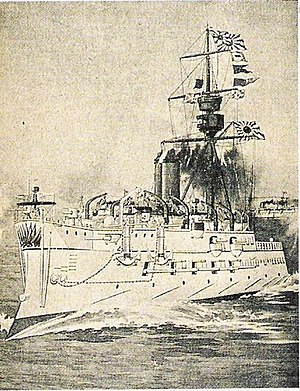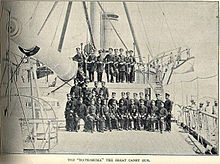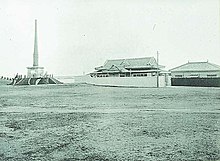Japanese cruiser Matsushima
 Matsushima, flagship of the Japanese Navy in the Sino-Japanese War.
| |
| History | |
|---|---|
| Name | Matsushima |
| Ordered | 1886 Fiscal Year |
| Builder | Société Nouvelle des Forges et Chantiers de la Méditerranée, La Seyne-sur-Mer, France |
| Laid down | 17 February 1888 |
| Launched | 22 January 1890 |
| Completed | 5 April 1892 |
| Stricken | 31 July 1908 |
| Fate | Sunk after accidental explosion 30 April 1908 |
| General characteristics | |
| Class and type | Matsushima-class cruiser |
| Displacement | 4,217 long tons (4,285 t) |
| Length | 91.81 m (301 ft 3 in) w/l |
| Beam | 15.6 m (51 ft 2 in) |
| Draft | 6.05 m (19 ft 10 in) |
| Propulsion | 2-shaft reciprocating ; 6 boilers; 5,400 hp (4,000 kW), 680 tons coal |
| Speed | 16.5 knots (19.0 mph; 30.6 km/h) |
| Complement | 360 |
| Armament |
|
| Armor |
|
Matsushima (松島, Pine Island) was a
Background
Forming the backbone of the Imperial Japanese Navy during the First Sino-Japanese War, the Matsushima-class cruisers were based on the principles of Jeune École, as promoted by French military advisor and naval architect Louis-Émile Bertin.[1] The Japanese government did not have the resources or budget to build a battleship navy to counter the various foreign powers active in Asia; instead, Japan adopted the radical theory of using smaller, faster warships, with light armor and small caliber long-range guns, coupled with a massive single 320 mm (12.6 in) Canet gun. The design eventually proved impractical, as the recoil from the huge cannon was too much for a vessel of such small displacement, and its reloading time was impractically long; however, the Matsushima-class cruisers served their purpose well against the poorly equipped and poorly led Imperial Chinese Beiyang Fleet.
Matsushima was built by the Société Nouvelle des Forges et Chantiers de la Méditerranée naval shipyards at La Seyne-sur-Mer in France.
Design
Matsushima differed from her sister ships primarily in the location of her main gun, which was situated behind the superstructure instead of in the bow.
Matsushima had a steel hull with 94 frames constructed of mild steel, and a double bottom, divided into waterproof compartments, with the area between the bulkheads and armor filled with
The ship was driven by two horizontal
Service record
Matsushima arrived in Sasebo Naval District on 19 October 1892. As part of her shakedown cruise, from June to November 1893, Matsushima, Takachiho and Chiyoda made a 160-day, 7,000 nautical miles (13,000 km; 8,100 mi) navigational training cruise off the shores of China, Korea and Russia.
First Sino-Japanese War
After the start of the First Sino-Japanese War, Matsushima was the flagship of Admiral Itō Sukeyuki. She played a central role in the Battle of the Yalu River, as a part of the Japanese main body with Hashidate, Chiyoda and Itsukushima.[3] During the battle, the shortcomings of her design soon became evident - she was able to fire her Canet gun only four times, knocking out one of the guns on the Pingyuan. During the battle, one of the 259-mm shells from Pingyuan struck Matsushima in her unarmored starboard side, destroying her torpedo tubes, and killing four crewmen, but the shell failed to explode.[3] However, two of the 305-mm shells from the ironclad Zhenyuan also struck Matsushima. One failed to detonate, and passed through both sides of the hull. The other exploded, destroying the No.4 120-mm gun on the gun deck as it was being loaded, killing 28 crewmen and wounding 68 others. The fire from this explosion knocked three other guns out of commission, and only the quick action by a non-commissioned officer who stuffed his uniform into cracks in a bulkhead prevented the fire from spreading to an ammunition magazine. Matsushima also took numerous hits from smaller caliber artillery, damaging her smokestack, masts, and deck equipment, forcing her withdrawal from combat. In all, Matsushima lost 57 men (including three officers) and 54 wounded (including four officers) in the battle – more than half of the Japanese casualties during the entire battle.[4] Admiral Itō was forced to transfer his flag to Hashidate as Matsushima returned to Kure Naval Arsenal for repairs.
With crews working around the clock, Matsushima was able to return to active duty after 26 days, participating in the
Matsushima was among the Japanese fleet units that took part in the invasion of Taiwan in 1895, and saw action on 3 June 1895 at the bombardment of the Chinese coastal forts at Keelung.

Interwar years
Matsushima was among warships anchored in the
Matsushima was reclassified as a second-class cruiser on 21 March 1898. Prince Arisugawa Takehito was later appointed captain, followed by future admiral Uryū Sotokichi.
From 3 May 1898 to 15 September 1898, Matsushima was assigned to patrolling the sea lanes between Taiwan and Manila, during the period of heightened tension between Japan and the United States during the Spanish–American War.
In April 1900, Matsushima participated in large-scale naval maneuvers, and later that year escorted Japanese transports to China during the
In 1902, Matsushima was dispatched to
In 1903, Matsushima made the first of its long-distance navigational training voyages, visiting Southeast Asia and Australia.

Russo-Japanese War
During the
During the Battle of the Yellow Sea of 10 August, Matsushima shadowed the Russian fleet, but was unable to close to combat distance. After the end of the Battle of Port Arthur, Matsushima was reassigned to Hakodate for patrols of the Tsugaru Strait. During this time, she captured the British-flagged steamship Istria with a cargo of contraband coal attempting to run the Japanese blockade into Port Arthur, but her capture was overturned in a Japanese prize court. On 28 February, she was briefly trapped in sea ice off of the island of Kunashir, but managed to break free, losing her right propeller and damaging some of her armor plating. She was repaired from March–April 1905 at the Sasebo Naval Arsenal.
At the final Battle of Tsushima, Matsushima was assigned to the 5th Division of the Japanese fleet. At the end of the first day of the battle, she was able to attack the cruisers Oleg and Aurora, but took a hit in return which damaged her steering and put her out of action until repairs could be completed.[8] The following day, she covered the surrender of the remnants of the Russian fleet by Admiral Nebogatov. After the battle, she continued in patrols of the Korea Strait.
Later Matsushima was assigned as flagship of Admiral
Final years

After the end of the war, Matsushima reverted to her former role as a training vessel, making long-distance navigational training cruises with Imperial Japanese Naval Academy cadets to Southeast Asia and Australia in 1906, 1907 and 1908.
On 30 April 1908, while anchored at
A memorial to the Matsushima-class ships in general, and Matsushima in particular, is located at the temple of Omido-ji in
Gallery
-
A 1905 post card
-
Off the Pescadores islands, 1895
-
With parade pennants, 1896
Notes
- ^ Roksund, The Jeune École: The Strategy of the Weak;
- ^ a b c Chesneau, Conway's All the World's Fighting Ships 1860–1905, page 227
- ^ .
- ^ Paine, The Sino-Japanese War of 1894-1895: Perception, Power, and Primacy page 133-134
- ISBN 0-8317-0302-4, p. 219.
- ^ steelnavy.net Fuso Japanese Battleship 1900
- ^ a b Lengerer, Hans (September 2007). Ahlberg, Lars, ed. "The IJN's First Warship Order to a Foreign Country: Armoured Frigate Fusô and Belted Corvettes Kongô and Hiei – Part III". Contributions to the History of Imperial Japanese Warships (Paper III), p. 46.
- ^ Howarth, The Fighting Ships of the Rising Sun
- ^ "MATSUSHIMA DISASTER". The Sydney Morning Herald. No. 21, 960. New South Wales, Australia. 4 June 1908. p. 6. Retrieved 17 March 2018 – via National Library of Australia.
References
- Chesneau, Roger (1979). Conway's All the World's Fighting Ships 1860–1905. Conway Maritime Press. ISBN 978-0-85177-133-5.
- David C. Evans; Mark R. Peattie (1997). Kaigun: Strategy, Tactics, and Technology in the Imperial Japanese Navy, 1887-1941. Naval Institute Press. ISBN 978-0-87021-192-8.
- Howarth, Stephen (1983). The Fighting Ships of the Rising Sun: The Drama of the Imperial Japanese Navy, 1895-1945. Atheneum. ISBN 978-0-689-11402-1.
- Jane, Fred T. (1904). The Imperial Japanese Navy. Thacker, Spink & Co.
- Jentsura, Hansgeorg (1976). Warships of the Imperial Japanese Navy, 1869-1945. Annapolis, MD: Naval Institute Press. ISBN 978-0-87021-893-4.
- Roberts, John (ed). (1983). 'Warships of the world from 1860 to 1905 - Volume 2: United States, Japan and Russia. Bernard & Graefe Verlag, Koblenz. ISBN 978-3-7637-5403-8.
- Roksund, Arne (2007). The Jeune École: The Strategy of the Weak. Leiden: Brill. ISBN 978-90-04-15723-1.
- Schencking, J. Charles (2005). Making Waves: Politics, Propaganda, And The Emergence Of The Imperial Japanese Navy, 1868-1922. Stanford University Press. ISBN 978-0-8047-4977-0.



